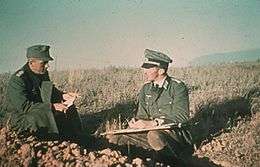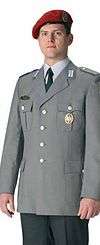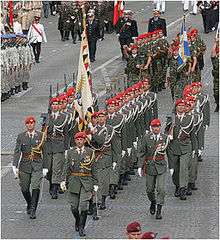Feldgrau
| Feldgrau | |
|---|---|
| Hex triplet | #4D5D53 |
| sRGBB (r, g, b) | (77, 93, 83) |
| HSV (h, s, v) | (56°, 7%, 14%) |
| Source | Mindjunker |
|
B: Normalized to [0–255] (byte) | |


Feldgrau (field-grey) has been the official basic color of military uniforms of the German armed forces from the early 20th century until 1945 or 1989 respectively. However, according to the color code there was no exact scientific definition, so slightly different grey tinctures were possible. Armed forces of other countries selected slight variations or shades of that color according to the German Feldgrau. Metaphorically, feldgrau used to refer to the armies of Germany (the Imperial German Army and the Heer [en: ground forces, or army] component of the Reichswehr and the Wehrmacht).
Abstracts
Colloquially, today feldgrau means plainly the color of the German uniform, especially for World War II, but also for the East German National People's Army, under the description steingrau (stone-grey). Feldgrau was introduced to the Austrian Bundesheer in line to the German pattern as well.
By World War I the color feldgrau was a light grey-green, though there is no specific color, rather a color range of greys to browns, that was one of the first standardized uniforms suitable to the age of smokeless gunpowder.
History
In 1910 the so-called field-grey peace uniform (feldgraue Friedensuniform), with colored cuffs, facings, shoulder straps and gorgets was disposed by decree in Prussia, followed by all other German countries and armies, last by the Bavarian Army in April 1916. Formerly most infantry regiments in the German Imperial Army wore "Prussian blue" tunics, although Bavarian units had light blue and jägers dark green. Cavalry uniforms were of a wide range of colours. With the adoption of field-grey the bright coloured uniforms were reserved for parade and off-duty wear until the outbreak of war in 1914.
Simultaneously it characterised the end of a variety of different colored uniforms in German states. With that new unique “field-grey peace uniform” the Deutsches Heer started military campaigns in World War I.
Other countries selected feldgrau as the basic color for uniforms, shoulder straps, sleeve insignia, or pieces of equipment etc. as well. So was feldgrau introduced by the Swedish Armed Forces in 1923 in line to the German pattern.
Other countries today
Austria
%2C_2010.jpg)

In 1909 the Austro-Hungarian Army adopted the pike-grey (Hechtgrau) as the colour of the field service uniform of its infantry, artillery, engineers and transport units. Previously it had been reserved for Jaeger and Landwehr regiments. Following the outbreak of World War I the light blue-grey shade of Hechtgrau proved unsuited for campaigning in Europe and from 1915 onwards the grey-green feldgrau was substituted.
With the formation of the Austrian 1st Federation's Armed Forces in 1929, there was a close orientation to Germany. For instance the feldgrau uniform (providing some camouflage features) and the corps colors of rank insignia adopted. However, slightly different grey shades were possible as well.
Today, in accordance with national traditions, the textile color of the Austrian 2nd Federation's Armed Forces is named feldgrau (also braungrau [en: brown-grey] - uniform jacket), and steingrau (also steingrau-oliv (stone-grey-olive), or more popularly NATO-oliv (NATO-olive) uniform trousers).
Chile
The Chilean Army also wears a full dress uniform in feldgrau.
Finland
The current dress uniform of the Finnish Army (M/83) is a grey inform patterned after the German 1944 uniform. Finnish Army has used grey uniforms since its founding in 1918. M/83 and its equally grey predecessors were used as the common service uniform up to the 1980s, with camouflage (M/62) used only in the field uniform. Today, the common service uniform is a camouflage uniform (M/62, M/91 or M/05).
Sweden
The Swedish Armed Forces used a very similar color for infantry uniforms, for example the grey m/39 and later on grey-green as the German ones. The last uniform to use the color was the woollen m/58 winter uniform.
Shades of grey
The table below shows some shades of grey in line to the rough RAL colors
| Number | Sample | CIELAB L* | CIELAB a* | CIELAB b* | German name | English name | Description and examples |
|---|---|---|---|---|---|---|---|
| #5d5d3d (HTML-code) | Feldgrau | Field grey | Basic color Feldgrau of the Reichsheer and Reichswehr 1907–1935 | ||||
| #4D5D53 | Feldgrau | Field grey | Basic color of the Wehrmacht 1937–1945 | ||||
| #555548 | Steingrau | Stone grey | Basic color of the GDR National People's Army 1956–1989 | ||||
| RAL 7000 | 58.32 | −3.14 | −4.71 | Fehgrau | Squirrel grey | surface camouflage paint to vessels of the Deutschen Marine | |
| RAL 7008 | 45.91 | 3.34 | 17.92 | Khakigrau | Khaki grey | original name: Graugrün (Grey green) | |
| RAL 7009 | 43.19 | −2.43 | 3.87 | Grüngrau | Green grey | original name: Feldgrau Nr.2 (Field grey No.2) | |
| RAL 7013 | 39.21 | 0.59 | 6.33 | Feldgrau/Steingrau | Field grey/Stone grey | Austrian Bundesheer | |
| RAL 7016 | 33.84 | −1.33 | −2.83 | Anthrazitgrau | Anthracite grey | Added for use by the Wehrmacht | |
| RAL 7021 | 30.65 | −0.43 | −1.22 | Schwarzgrau | Black grey | 1937 added for use by the Wehrmacht under the name Dunkelgrau (dark grey) | |
| RAL 7037 | 30.65 | −0.43 | −1.22 | Staubgrau | Dust grey | since 1956 used by the German Bundeswehr under the Hellgrau (light grey) |


